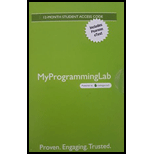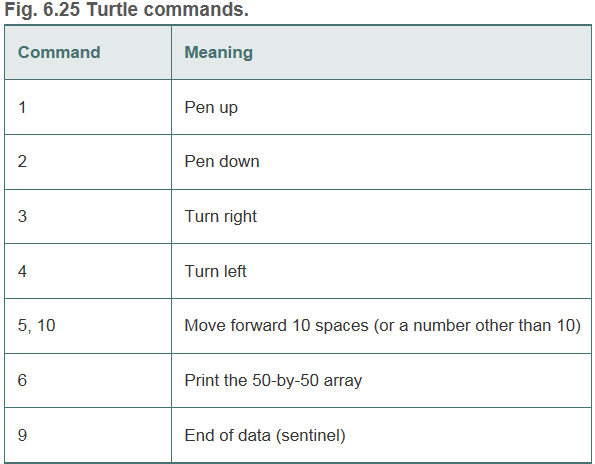
(Turtle Graphics) The Logo language made the concept of turtle graphics famous. Imagine a
Use a 50-by-50 array floor which is initialized to zeros. Read commands from an array that contains them. Keep track of the current turtle position at all times and whether the pen is currently up or down. Assume that the turtle always starts at position 0, 0 of the floor with its pen up. The set of turtle commands your program must process are shown in Fig. 6.25. Suppose that the turtle is somewhere near the center of the floor. The following “program” would draw and print a 12-by-12 square:
2
5, 12
3
5, 12
3
5, 12
3
5, 12
1
6
9
As the turtle moves with the pen down, set the appropriate elements of array floor to 1S. When the 6 command (print) is given, wherever there’s a 1 in the array, display an asterisk, or some other character you choose. Wherever there’s a zero, display a blank. Write a program to implement the turtle graphics capabilities discussed here. Write several turtle graphics programs to draw interesting shapes. Add other commands to increase the power of your turtle graphics language.

Want to see the full answer?
Check out a sample textbook solution
Chapter 6 Solutions
MYPROGRAMMINGLAB WITH PEARSON ETEXT
Additional Engineering Textbook Solutions
Starting Out with Java: From Control Structures through Objects (7th Edition) (What's New in Computer Science)
Thinking Like an Engineer: An Active Learning Approach (4th Edition)
Problem Solving with C++ (10th Edition)
Electric Circuits. (11th Edition)
Java How to Program, Early Objects (11th Edition) (Deitel: How to Program)
Starting Out with Programming Logic and Design (5th Edition) (What's New in Computer Science)
- In cell C16, enter a formula to calculate the price of the vehicle minus your available cash (from cell A3 in the Data worksheet). Use absolute references where appropriate—you will be copying this formula across the row what fomula would i use and how do i solve itarrow_forwardWhat types of data visualizations or tools based on data visualizations have you used professionally, whether in a current or past position? What types of data did they involve? What, in your experience, is the value these data views or tools added to your performance or productivity?arrow_forwardQuestion: Finding the smallest element and its row index and column index in 2D Array: 1. Write a public Java class min2D. 2. In min2D, write a main method. 3. In the main method, create a 2-D array myArray with 2 rows and 5 columns: {{10, 21, 20, 13, 1}, {2, 6, 7, 8, 14}}. 4. Then, use a nested for loop to find the smallest element and its row index and column index. 5. Print the smallest element and its row index and column index on Java Consolearrow_forward
- (using R)The iris data set in R gives the measurements in centimeters of the variables sepal length and width andpetal length and width, respectively, for 50 flowers from each of 3 species of iris, setosa, versicolor, andvirginica. Use the iris data set and the t.test function, test if the mean of pepal length of iris flowers isgreater than the mean of sepal length.The iris data set in R gives the measurements in centimeters of the variables sepal length and width andpetal length and width, respectively, for 50 flowers from each of 3 species of iris, setosa, versicolor, andvirginica. Use the iris data set and the t.test function, test if the mean of pepal length of iris flowers isgreater than the mean of sepal length.arrow_forwardRecognizing the Use of Steganography in Forensic Evidence (4e)Digital Forensics, Investigation, and Response, Fourth Edition - Lab 02arrow_forwardWrite a Java Program to manage student information of a university. The Javaprogram does the following steps:a) The program must use single-dimensional arrays to store the studentinformation such as Student ID, Name and Major.b) The program asks the user to provide the number of students.c) The program asks the user to enter the Student IDs for the number of studentsand stores them.d) The program asks the user to enter the corresponding names for the numberof students and stores them.e) The program then asks the user to provide the corresponding major for thestudents and stores them.f) The program then should display the following options:1. ID Search2. Major Enrollment3. Exitg) On selecting option 1, the user can search for a student using Student ID. Theprogram asks the user to enter a Student ID. It then should print thecorresponding student’s details such as Name and Major if the user providedStudent ID number is present in the stored data. If the user’s Student IDnumber does not…arrow_forward
- (a) Algebraically determine the output state |q3q2q1q0> (which is a 4-qubitvector in 16-dimensional Hilbert space). Show all steps of your calculations. (b) Run a Qiskit code which implements the circuit and append threemeasurement gates to measure the (partial) output state |q2q1q0> (which is a 3-qubit vector in 8-dimensional Hilbert space). this is for quantum soft dev class, you can use stuff like Deutsch Jozsa if u wantarrow_forwardWrite a C++ program that will count from 1 to 10 by 1. The default output should be 1, 2, 3, 4, 5, 6 , 7, 8, 9, 10 There should be only a newline after the last number. Each number except the last should be followed by a comma and a space. To make your program more functional, you should parse command line arguments and change behavior based on their values. Argument Parameter Action -f, --first yes, an integer Change place you start counting -l, --last yes, an integer Change place you end counting -s, --skip optional, an integer, 1 if not specified Change the amount you add to the counter each iteration -h, --help none Print a help message including these instructions. -j, --joke none Tell a number based joke. So, if your program is called counter counter -f 10 --last 4 --skip 2 should produce 10, 8, 6, 4 Please use the last supplied argument. If your code is called counter, counter -f 4 -f 5 -f 6 should count from 6. You should count from first to last inclusively.…arrow_forwardWrite a program that will count from 1 to 10 by 1. The default output should be 1, 2, 3, 4, 5, 6 , 7, 8, 9, 10 There should be only a newline after the last number. Each number except the last should be followed by a comma and a space. To make your program more functional, you should parse command line arguments and change behavior based on their values. Argument Parameter Action -f, --first yes, an integer Change place you start counting -l, --last yes, an integer Change place you end counting -s, --skip optional, an integer, 1 if not specified Change the amount you add to the counter each iteration -h, --help none Print a help message including these instructions. -j, --joke none Tell a number based joke. So, if your program is called counter counter -f 10 --last 4 --skip 2 should produce 10, 8, 6, 4 Please use the last supplied argument. If your code is called counter, counter -f 4 -f 5 -f 6 should count from 6. You should count from first to last inclusively. You…arrow_forward
 C++ for Engineers and ScientistsComputer ScienceISBN:9781133187844Author:Bronson, Gary J.Publisher:Course Technology Ptr
C++ for Engineers and ScientistsComputer ScienceISBN:9781133187844Author:Bronson, Gary J.Publisher:Course Technology Ptr EBK JAVA PROGRAMMINGComputer ScienceISBN:9781337671385Author:FARRELLPublisher:CENGAGE LEARNING - CONSIGNMENTProgramming Logic & Design ComprehensiveComputer ScienceISBN:9781337669405Author:FARRELLPublisher:Cengage
EBK JAVA PROGRAMMINGComputer ScienceISBN:9781337671385Author:FARRELLPublisher:CENGAGE LEARNING - CONSIGNMENTProgramming Logic & Design ComprehensiveComputer ScienceISBN:9781337669405Author:FARRELLPublisher:Cengage C++ Programming: From Problem Analysis to Program...Computer ScienceISBN:9781337102087Author:D. S. MalikPublisher:Cengage Learning
C++ Programming: From Problem Analysis to Program...Computer ScienceISBN:9781337102087Author:D. S. MalikPublisher:Cengage Learning Microsoft Visual C#Computer ScienceISBN:9781337102100Author:Joyce, Farrell.Publisher:Cengage Learning,
Microsoft Visual C#Computer ScienceISBN:9781337102100Author:Joyce, Farrell.Publisher:Cengage Learning, Programming with Microsoft Visual Basic 2017Computer ScienceISBN:9781337102124Author:Diane ZakPublisher:Cengage Learning
Programming with Microsoft Visual Basic 2017Computer ScienceISBN:9781337102124Author:Diane ZakPublisher:Cengage Learning





